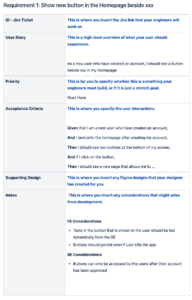In today’s data-driven business world, collecting and analyzing data is essential for making informed decisions and driving business growth. To ensure that your analytics efforts are effective, it’s crucial to gather complete and accurate requirements from stakeholders. This comprehensive template will guide you through the process of collecting requirements for your analytics project.
By using this template, you can systematically capture essential information, such as business objectives, data sources, key performance indicators (KPIs), user personas, and technical constraints. This structured approach ensures that all necessary information is gathered, reducing the risk of omissions or oversights.
Defining Project Scope and Objectives
Start by clearly defining the scope and objectives of your analytics project. This involves understanding the specific business problems or opportunities that you want to address with analytics. Define clear and measurable goals, aligning them with your overall business strategy.
Next, identify the key stakeholders who will be involved in the project. Consider their perspectives and expertise to ensure that all relevant requirements are captured. Determine their roles and responsibilities, and establish a clear communication plan to keep everyone informed.
Thoroughly research and understand the data sources that will be used in your analysis. Determine the types of data available, their accuracy, and any limitations or constraints. Assess the accessibility and availability of data, as well as the data collection methods and processes.
Define the key performance indicators (KPIs) that you want to track and measure. KPIs should be specific, measurable, achievable, relevant, and time-bound. Carefully consider how these KPIs align with your project objectives and ensure that they provide meaningful insights.
Technical Considerations and Limitations
Identify the technical tools and platforms that will be used for data collection, analysis, and reporting. Assess their capabilities, limitations, and compatibility with your data sources. Determine the data storage and security requirements, ensuring that data is handled ethically and in compliance with relevant regulations.
Consider the user personas that will be using the analytics reports and dashboards. Understand their needs, technical skills, and preferred formats. Design reports and dashboards that are user-friendly, visually appealing, and easy to interpret.
Anticipate potential technical challenges and identify contingency plans to address them. This includes considering data quality issues, data integration challenges, and scalability concerns. By planning for potential roadblocks, you can minimize the impact on your project timeline and ensure a successful implementation.
Finally, establish a process for ongoing monitoring and evaluation of the analytics project. Regularly review the performance of the project against its defined objectives and identify areas for improvement. Adjust your requirements and approach as needed to ensure that your analytics efforts remain aligned with your evolving business needs.
Conclusion
By utilizing an analytics requirements gathering template, you can systematically gather complete and accurate information, ensuring the success of your analytics project. This structured approach reduces the risk of omissions or oversights, ensuring that all necessary information is captured.
Remember to involve stakeholders, research data sources, define KPIs, consider technical factors, and establish a monitoring process. By following these best practices, you can lay a solid foundation for effective data analysis and decision-making, driving business growth and success.

